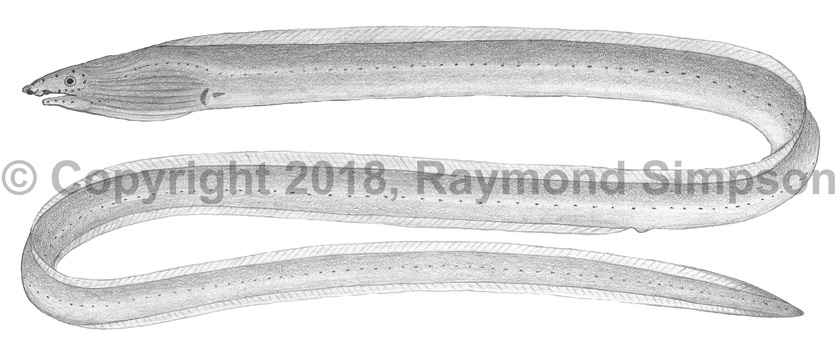
Common Name
Whip Eel
Year Described
Goode & Bean, 1880
Identification
Vertebrae: 151-173 (79-89 pre-anal)
Supraorbital pores: 1+3
Body extremely elongate and cylindrical in cross-section. Trunk length a little longer than tail (50-58%). Snout pointed and overhangs jaw. Underside of snout flattened with a toothed (3 teeth) median groove reaching anterior nostril. Anterior nostril tubular on underside of snout. Posterior nostril opens in mouth. Eye small over rear third of jaw. Jaw downturned and small. Teeth small and uniserial in both jaws (sometimes partly a second row on upper jaw). Vomerine teeth in two rows. Intermaxillary teeth present. Head pores well developed. Gill pouches and body grooved. Gill openings low on body and strongly converging anteriorly. Dorsal and anal fins present but low. Dorsal fin begins on top of head. Pectoral fin minute (base 12.3-35% length of gill opening), rounded, and low on body. Caudal fin absent. Tail tip hard and pointed. Lateral line complete.
Color
Body strongly bicolored dark brown and cream, with a sharp demarcation along lateral line. Pores noticeably lighter. Gill opening dark. Head also bicolored with a few random white blotches. Dorsal fin white with a thin dark edge rearward.
Size
Maximum size to 77cm TL.
Habitat
Found on sandy bottoms in shallow water and surf zone (1-46m).
Range
North Carolina to the Gulf of Mexico and the Yucatan Peninsula. Continental only.
References
Leiby, M. M., & R. W. Yerger. 1980. The genus Bascanichthys (Pisces: Ophichthidae) in the Gulf of Mexico. Copeia, 402-408.
Moreno, F., A. Acero P, & M. Grijalba-Bendeck. 2016. A new species of sand eel genus Bascanichthys (Anguilliformes: Ophichthidae) from the Caribbean. Boletín de Investigaciones Marinas y Costeras-INVEMAR, 45(1), 7-14.
Other Notes
The only sympatric related species is Bascanichthys bascanium, which is easily distinguished by non-contrasting lateral pores, higher vertebral counts and pectoral fin size.